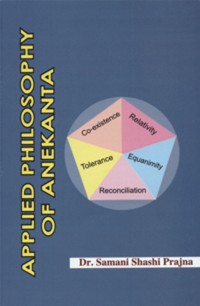The problem today is not the differences in cultures and 'isms' but is of understanding other as other and intolerance towards others. Due to this, many conflicts and violence take place. Scientific analysis of conflict has become a major feature of contemporary society. In recent times political, racial, individual, social, structural, ethnic, communal violence especially cultural and religious violence have caused much concern and anxiety to the collective consciousness of the people. The main cause of all sorts of conflicts is:
- Absence of communication,
- Imposition of decision,
- Absolute feeling of 'the other',
- Superiority complex.
Various steps by different social reformers have been undertaken in order to control such conflicts and violence. In 20th century Gandhi and Ācārya Tulsi really endeavored for this. Gandhi even gave the principles such as:
- Recognition of basic equality of all,
- Faith in the goodness of the other,
- Love for the opposser.[1]
Gandhiji negotiated even with the opponents believing that even the worst enemy has some truth to which the other party has to listen to. In this field,Inter-cultural dialogue can provide the best measures to have a peaceful world. In the present era, many inter-cultural, inter-religious, and intra-religious dialogues are being organized. These dialogues are leading towards conflict resolution through Jain doctrine of anekāntavāda. Anekānta is not merely a metaphysical concept, but it is practically a relevant concept. It is a philosophy of co-existence in the words of Mahaprajña, "A kind of intellectual non-violence, which changes the absolutistic framework of the brain.’’ It says everything is relative and multi-dimensional having inbuilt co-existence of opposites.’’ Claude Levi Strauss rightly said that a word is meaningful because of its binary 'other' word. Thus the 'light' and the 'dark' words give meaning to each other by a binary relation. A single word by itself has no meaning. Similarly a single culture has no meaning in the absence of the other. Jacque Derrida goes one step further. He says that a word includes its other within its meaning. It just depends upon the view that which one is in the focus and which one is in the margin. He refers to Plato's use of the word 'pharmacon'.[2] The word 'pharmacon' means medicine, elixir of life as well as poison. Thus the word contains opposites as its meaning. Likewise anekānta philosophy accepts the different levels of human perceptions and cultures and does not give privileged treatment to one particular thought. It pleads for different cultures as part and parcel of proper cultural department. Inter-religious and inter-cultural dialogue rejects the two hermeneutics model, hermeneutics of total identity of modernity and of radical difference of post-modernity and pleads for third model of Analogous Hermeneutics[3] i.e. the anekāntic way of interpretation, which collaborates different cultures keeping its identity in a single whole. In Jain canon Sūtrakṛtāṅga, Mahāvīra says, ‘’to praise ones belief and degrading the others faith leads a man of absolute perspective to unending problems and sorrow.’’[4] So one cannot arrive at the truth, by disowning others truth, simply because they are other people's truth. In inter-cultural dialogue with reference to anekānta, one tries to understand the other from their point of view. Truth cannot be unified. As Ricoeur rightly remarks that, ‘uniformization of truth is, no doubt, a dream of reason but it is at the same time an act of violence.’ So under the umbrella of anekāntic, inter-cultural understanding, we accept the points of agreement and overlook points of disagreement which is meager, and helps in cultivating the virtue of respect for others faith and for a peaceful harmonious world.
 Dr. Samani Shashi Pragya
Dr. Samani Shashi Pragya

